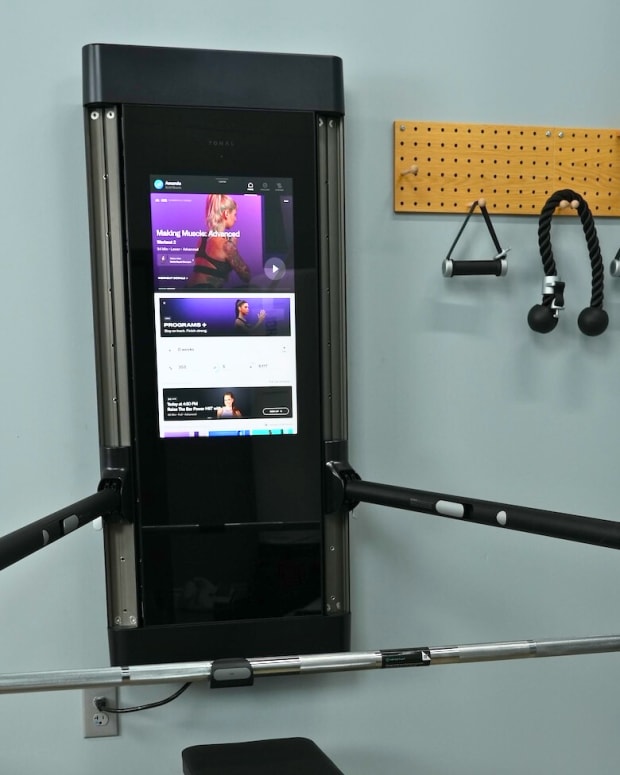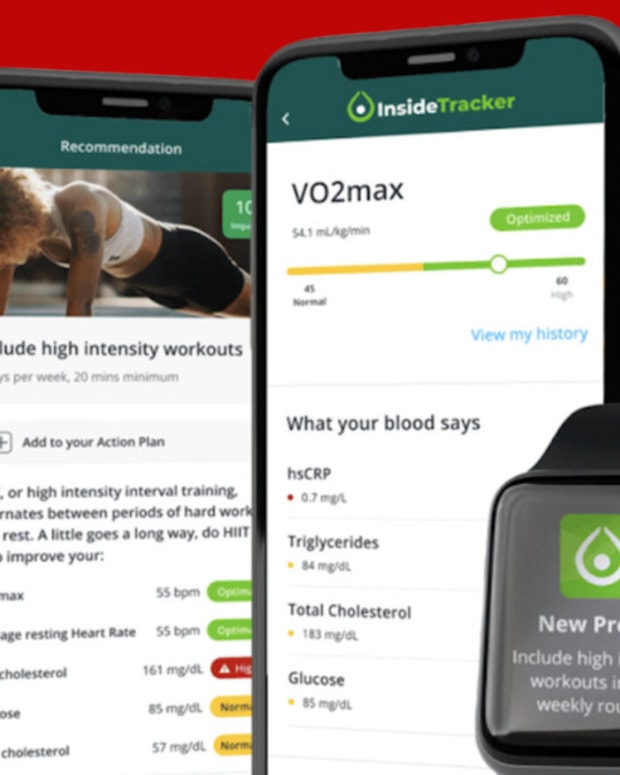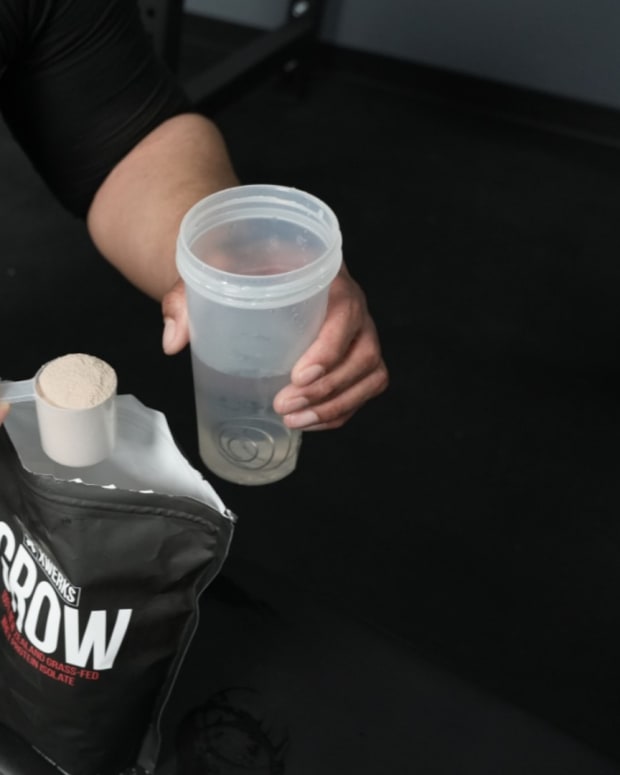The products featured in this article have been independently reviewed. When you buy something through the retail links on this page, we may earn commission at no cost to you, the reader. Sports Illustrated editorial staff are not involved in the creation of this content. Learn more here.
Boutique gyms that offer one type of workout class format are growing in popularity. These studios often feature motivating instructors, a pump-up playlist, a few repeated workout stations (such as weights and a treadmill) and even a tech element (like using heart rate monitors). One popular example: Orangetheory Fitness.
Orangetheory Fitness is a group fitness studio that offers a unique workout class centered around cardio and strength training exercises that are designed to elicit a heart rate in different color-coded heart rate zones. And right now, Orangetheory Fitness is offering your first class free.
In this article, we provide a comprehensive Orangetheory Fitness review, including the pros and cons of Orangetheory Fitness, how much Orangetheory Fitness costs, how the workouts are formatted, who it’s good for and how Orangetheory Fitness compares to CrossFit and other popular group fitness workout studios.
What is Orangetheory Fitness?
Key features:
- Free first class for new members
- 60-minute group fitness workouts based on heart rate zones
- Workouts utilize rowers, treadmills and strength conditioning
- Classes led by certified coaches provide a cardio and full-body strength training workout
- Orangetheory Fitness app to track your progress
- Different membership tiers
Orangetheory Fitness is a group fitness class franchise with more than 1,400 locations in the United States, over 100 locations in Canada and others spread around the world. Each workout is 60-minute heart-rate based class that blends cardio and strength-training exercises.
Classes are designed to not only burn a lot of calories during the workout—said to be around 500 or more per hour-long workout—but also boost metabolic rate post-workout. Interval-style training has been shown to increase excess post-exercise oxygen consumption (EPOC), commonly referred to as the “afterburn.” This essentially refers to an increase in your metabolism after vigorous exercise in order to help the body restore homeostasis and recover. The EPOC after interval workouts may last for upward of 14 hours after the workout is over.
In addition to featuring high-intensity intervals, Orangetheory Fitness workouts are based on the five heart rate zones. During class, you'll use an OTBeat heart rate monitor to track your effort. Heart rate zones (abbreviated HR zones in class) are based on the relative percentage of your maximum heart rate. The easier your intensity level, the lower your heart rate zone. Although heart-rate training has been used extensively in aerobic exercise training for decades, Orangetheory Fitness puts a slightly different spin on the normal five heart rate zones by assigning each HR zone or “intensity level” a color: gray, blue, green, orange and red.
The OTBeat communicates via Bluetooth and there is a screen at the front of the class that displays the minutes you’ve spent in each zone, helping ensure you accrue 12 minutes in the “orange zone.” You earn one “splat point” per minute spent in the orange or red zones. The goal is that every class member, regardless of fitness level, earns 12 splat points per class. Because heart-rate zones during exercise are relative to your fitness level, each person can be moving at different paces but be working at the same effort level.
There is also an Orangetheory Fitness app that you can access for free. It allows you to find studios, view classes and schedules, track your fitness challenges, benchmarks and workout metrics, log your out-of-studio workouts, view your body composition data and see workout summaries using the data gathered by your OTBeat device.
How much is Orangetheory Fitness?
There are a few different membership tiers for Orangetheory Fitness, with pricing structures dependent on location as well as membership level. There is no initiation fee for any of the membership levels, as you may find with other high-end gym memberships.
First time visitors get their first class free, which is said to be a $28 value.
The Orange Basic membership package costs an average of $69 per month, and gives members access to four classes per month. Additional classes can be purchased a la carte for $18 each.
The Orange Elite package costs around $99 to $109 per month, depending on studio location. This membership tier includes eight classes per month, with the option to purchase additional classes at a reduced rate. The Elite membership includes additional benefits, including a free daily Shakeology drink, discount on supplements and a 10 percent discount on private training sessions.
The Orange Premier membership is the highest membership tier. It costs around $159 and provides members with the option to take unlimited classes. Plus, you can bring family members to classes with you for a reduced guest rate, and you get a bigger supplement discount and free daily Shakeology drinks. Note, there is a late cancel fee and no-show fee of $12 per class at this membership tier.
If you do not want to sign up for a monthly membership package, you can purchase guest day passes or a 10-, 20- and 30-class package to use whenever you want. The prices for these class package passes run around $199, $359 and $499. The drop-in rate is $28 at most studios.
Related Post: Is a Planet Fitness Gym Membership for You?
One of the benefits of Orangetheory Fitness memberships is that they give you access to nationwide studio classes, so if you travel a lot, you can find a local Orangetheory Fitness studio and take a class there instead of your home studio.
How to cancel Orangetheory Fitness
There is no cancellation fee for Orangetheory Fitness. To cancel your membership, you need to contact your home studio location (where you signed up) and request a cancellation form. Complete the form and send it back to your home studio to complete your cancellation request. If you have further questions about canceling your membership, you can contact customer service.
Orangetheory Fitness also offers a “30-Day Quit-Free Guarantee.” At participating studios, you are able to get a refund for your monthly membership dues as long as you complete at least 12 Orangetheory Fitness classes at your home studio within the first 30 days of starting your membership and find that you are still dissatisfied with the experience.
The 30-day quit-free guarantee only applies to those who sign up for the Orangetheory Fitness Premier Membership.
Working out at Orangetheory Fitness
Orangetheory Fitness offers a free first workout for new prospective members. New members are told to arrive at least 30 minutes before your first workout. There is paperwork to fill out, you’ll get an orientation of the facility, a run-down on safety considerations and will be asked about your health and fitness goals.
The 60-minute class involves three different types of coach-led activities—rowing, treadmill running and strength-training exercises—each with its own purpose and benefits. Typically, each exercise is performed for 20 minutes, giving you a good mix of cardio and strength training by the end of the class.
The rowing machine is said to provide a full-body workout, using up to 86 percent of the muscles in the body, while also increasing heart rate like other forms of cardio exercise. The rowing machine portion of Orangetheory Fitness classes increases aerobic endurance, muscular strength and power.
After the rowing machine, the workout features cardio intervals on the treadmill.
After the treadmill intervals, the class moves to an open floor space for strength training exercises. This may include both weight training with dumbbells, kettlebells or other weights or bodyweight calisthenics.
Although some amount of time is spent in all the zones, most of the classes take place in the green, orange or red zones.
- Gray Zone: 50–60 percent of your maximum heart rate (MHR). This should feel very comfortable and conversational, like easy walking.
- Blue Zone: 61–70 percent of your maximum heart rate (MHR). Most warm-ups are supposed to occur in this zone.
- Green Zone: 71–83 percent of your maximum heart rate (MHR). This is the aerobic zone, or what Orangetheory Fitness calls your “base pace.” Cardio exercise should feel difficult, but manageable in this zone, so that you can do at least 20 minutes of cardio at this intensity without being completely breathless.
- Orange Zone: 84–91 percent of your maximum heart rate (MHR) is based on the orange zone, which the fitness program terms the “orange effect” or “afterburn.” This HR zone involves high-intensity exercise that causes a boost on your metabolic rate after the workout (EPOC). The goal in each class is to spend a minimum of 12 minutes in the orange zone during a 60-minute class.
- Red Zone: 92–100 percent of your maximum heart rate (MHR). The red zone is max effort. This is a sprint or “all out” effort that can only be sustained for about a minute.
The majority of workouts occur in the green, orange and red zones to maximize calorie burn, efficiency and EPOC. Orangetheory Fitness describes the Grey, Blue, Green, Orange and Red zones as resting, easy, challenging, uncomfortable and all out, respectively. The certified coach leading the class will tell you when to push yourself harder, and when to ease up for recovery.
These classes are notoriously difficult because they are designed to challenge you physically and mentally, torch a lot of calories and provide a total body workout. Some of the workouts are designated with certain things such as “endurance“ or “power.” These workouts will feature the same type of class format and still use the rowing machine, treadmill and weights for strength training, but the specific exercises performed and the structure and intensity of the intervals and cardio will be scaled differently based on the goal of the class.
Orangetheory Fitness claims that no two workout classes are the same, so the variety can be a welcome option for people who get bored with the same routine. Regardless of the theme or particular structure of any given class, the goal is always to earn a minimum of 12 “splat points,” with each splat point being earned per minute spent in the orange or red HR zones. This essentially correlates to any time your heart rate reaches at least 84 percent of your maximum heart rate.
The primary exercise equipment used in any class includes a stationary rower, a treadmill and free weights such as dumbbells or kettlebells. There are also alternative cardio machine options such as elliptical machines, exercise bikes, striders and steppers for those who need a low-impact alternative to treadmill running intervals. Suspension trainers, such as TRX straps, ab rollers and Bosu balls, may also be used during the strength training portion of the workout for bodyweight exercises.
How Long are Orangetheory Fitness Classes?
Orangetheory Fitness classes are 60 minutes.
Pros:
- Over 1,400 studios in the United States, more than 100 and others around the world, giving you access to workouts when you travel
- High-intensity classes are efficient for burning calories and boosting metabolic rate
- Lots of variety in the workouts, which helps pass the time and prevents boredom
- Classes based on the concept of HR training, which is relative to your own fitness level so different ability levels can all participate in the same class
- Workouts focus on heart-rate training through cardio and strength, which can help people meet the guidelines for physical activity for adults
- Ability to track your progress using the OTBeat heart rate monitor on the screen in the class and via the Orangetheory Fitness app
- There are low-impact alternatives to the treadmill for those with joint pain or who can’t run
- Monthly challenges to increase motivation and accountability
- Group exercise can be motivating and can help pass the time
- Classes taught by certified coaches
- First class is free
Cons:
- Expensive membership fees with high costs per class
- Not ideal for building muscle
- May be too intensive for beginners, and 60 minutes is a long time commitment and requires good endurance
- No one-on-one coaching for beginners
Who should and shouldn’t get an Orangetheory Fitness membership?
People who have the financial means to afford Orangetheory Fitness classes and who enjoy the group fitness atmosphere should consider getting a membership. Classes are said to be fun. They provide a full-body workout, improve numerous aspects of fitness simultaneously including cardio endurance and muscular strength, are efficient in terms of calorie burning and the flexibility in memberships allows you to take a class at any of the studios nationwide or around the world. Therefore, if you travel a lot, a membership can also be a good investment because you can take your workout routine with you on the road and take a class at an Orangetheory Fitness studio in your destination.
People who need extra accountability, like the guidance of working with a coach rather than devising their own workouts and want no two workouts to be the same also will be well served by getting a membership.
Another benefit of Orangetheory Fitness classes is that there aren’t a lot of highly technical skills and exercises to learn, so it can be relatively beginner friendly. Certain group fitness franchises such as CrossFit and F45 are more skill-based and have advanced moves in the workouts that require more technique and experience to execute. CrossFit equipment can be intimidating if you’ve never used it before.
However, if your primary goal is building muscle, these classes are not the best fit. Although there is a strength training portion of Orangetheory Fitness classes, many of the exercises are bodyweight exercises or circuit training exercises performed with light weights. The strength training exercises can help you get stronger but are not really designed for hypertrophy, or muscle growth, which requires lifting heavier weights and doing higher-volume resistance training.
An Orangetheory Fitness membership is also costly on a per-class basis if you cannot afford the premium membership plan or do not intend on taking enough classes per week to make an unlimited plan a good value. Therefore, if you are on a budget, this membership is typically not the best option for your fitness routine.
Lastly, if you would like to design and control your own workouts, or you want one-on-one guidance from a personal trainer, the group fitness style of Orangetheory Fitness will not be a good fit.
Other amenities and equipment
Orangetheory Fitness studios are really designed only for the typical group exercise class format offered. There are very few other amenities that you would find in a typical gym, such as Planet Fitness, Equinox or LifeTime Fitness.
- Tanning beds? No
- Showers? Yes
- Lockers? Yes, but no dedicated locker rooms.
- Yoga? No
- Childcare? No
- Pool? No
- Sauna? No
- Towel Service? No
- Smoothie Bar? No
Orangetheory Fitness vs. CrossFit
CrossFit and Orangetheory Fitness are both forms of structured, proprietary group exercise classes that occur in their own branded franchises. Both CrossFit and Orangetheory Fitness classes feature varied, full-body workouts that are meant to target all major muscle groups, boost metabolism and increase heart rate to provide an efficient, well-rounded workout. The primary difference between CrossFit and Orangetheory Fitness is that CrossFit workouts focus on functional movement (movements that translate to functions performed in everyday life) and work capacity (how much work you can do in a given period of time) whereas Orangetheory Fitness classes focus on working within certain heart-rate zones to torch more calories and increase EPOC. CrossFit also places a greater emphasis on muscle building and strength training, whereas Orangetheory Fitness classes are somewhat more metabolic- and cardio-focused.
CrossFit workouts combine weightlifting, powerlifting, monostructural training (run/row/bike) and calisthenics movements, and the way the class is structured depends on the gym owner or trainer. There is also a strong emphasis on learning foundational movement patterns such as squatting, pressing and rowing. In both Orangetheory Fitness and CrossFit classes, you will find a mix of people of different fitness levels all participating in the same class, modifying exercises or working at their own relative intensity based on their experience and fitness levels. CrossFit workouts typically involve lifting heavier weights, which can lead to hypertrophy (muscle building) whereas the strength training caution in Orangetheory Fitness classes is only a component of the overall work out, and typically involves working with lighter weights in a circuit training fashion to keep heart rate high, but not necessarily support significant muscle building.
The equipment found at a CrossFit studio also differs from that at Orangetheory Fitness. Orangetheory Fitness has cardio exercise equipment such as treadmills, exercise bikes, rollers and striders. There are also dumbbells, medicine balls, weight benches, kettlebells, TRX suspension trainers and Bosu balls. There is no equipment or powerlifting, such as power racks, squat racks, functional trainers or a cable machine, deadlifts platforms or Olympic weight plates and barbells.
Both workout classes tend to be 60 minutes long and are led by certified coaches or personal trainers. CrossFit features what they call a “WOD,” which is the “workout of the day.“ They do not use heart rate monitoring, and there is no screen at the front of the class that displays your heart rate zones as there is with Orangetheory Fitness classes.
Orangetheory Fitness vs. F45
Both Orangetheory Fitness and F45 are group exercise classes, but F45 focuses more on functional movements such as squatting rather than cardio and metabolic conditioning. With that said, although F45 is primarily considered a functional training group exercise class, the workouts combine cardio, high-intensity interval training (HIIT), plyometrics and strength training into one. With the exception of the addition of plyometrics, this is similar to the blend of exercises offered by Orangetheory Fitness. However, while Orangetheory Fitness typically portions the class into 20 minute sections on the rowing machine, treadmill and then open floor for strength training, an F45 class uses a circuit training style, where you spend a predetermined amount of time at a particular exercise station before moving on to the next station.
Although there are F45 coaches, they do not lead the entire workout; rather, they demonstrate the moves, and then participants follow along with the workout on a big screen. Another difference between Orangetheory Fitness and F45 is that F45 offers 45-minute classes whereas Orangetheory Fitness classes are one hour.
Related Post: F45 vs Orangetheory: Which Workout Is Right For You?
Orangetheory Fitness FAQs
Is Orangetheory Fitness hard for beginners?
Because the workouts are designed to be based on your own exertion level using your heart rate, beginners can take the same class as advanced athletes. Beginners can work at their own slower pace, and the relative effort level, or HR zone, will still be the same as a fitter individual working at a faster pace. For example, when doing intervals on the treadmill, a beginner may run the high intensity interval portions at a 12-minute mile whereas an advanced person might be sprinting at a six-minute mile pace, yet both participants would be working in their own personal “orange zone.” The one challenge for beginners is that the classes are 60 minutes, which requires a lot of endurance. However, beginners can always stop and rest if they need to or sit out certain exercises to take extra recovery time.
Is Orangetheory Fitness good for weight loss?
Orangetheory Fitness can be good for weight loss. Research has found that interval workouts can burn a lot of calories. However, your weight loss results will depend on how your classes fit into the context of your diet and physical activity outside of classes, how hard you push yourself and how often you take Orangetheory Fitness classes.
How many times a week should you do Orangetheory Fitness?
The number of times per week you should do Orangetheory Fitness classes depends on your overall fitness routine. Orangetheory Fitness recommends taking three to four classes per week. The physical activity guidelines for adults set forth by the Centers of Disease Control and Prevention and the British Heart Foundation are to accumulate either 150 minutes of moderate-intensity aerobic exercise or 75 minutes of vigorous-intensity cardio exercise per week plus two total-body strength training workouts.
What should I wear to Orangetheory Fitness?
Orangetheory Fitness recommends wearing basic athletic attire to classes. This can include sneakers, a lightweight T-shirt or tank top that’s loose enough to easily strap on your OTbeat device and a pair of gym shorts, joggers or leggings. Some people start the workout with a hoodie on as well, depending on your preferences, the studio temperature, weather and where you live. Flip-flops, sandals and long pants are discouraged, as is any jewelry.
Is Orangetheory Fitness hard on your body?
Yes and no. As the classes are designed as a heart-rate based workout, you will feel a challenged. This workout style induces a significant increase in your excess post-exercise oxygen consumption (EPOC). There is also some treadmill running, which is considered a high-impact exercise. However, rowing is another major component of Orangetheory Fitness workouts, and it is a low-impact exercise. Your workout is also based on your own personal heart rate zones, so the intensity of your workout is relative to how hard you are pushing your body and your own fitness level.
Is Orangetheory Fitness HIIT or cardio?
Orangetheory Fitness combines heart-rate based training and cardio into one workout. You will do treadmill running (or elliptical machine or strider if you need low-impact exercise) and rowing, as well as strength training exercises in every class. You will spend time in different heart rate zones, with some higher intensity sections and other cardio-based exercises at lower intensities.
How many calories do you burn at Orangetheory Fitness?
The number of calories you burn during each workout depends on your body weight and the intensity you are working at. Members are given an OTBeat heart rate monitor to help track the calories burned during your workouts. Orangetheory Fitness reports that the average member can expect to burn nearly 500 calories per class or more.
What’s the difference between Orangetheory Fitness and CrossFit?
CrossFit is more strength focused and geared towards functional movement training whereas Orangetheory Fitness is a heart-rate based workout with a stronger cardio focus, designed to elevate your metabolic rate.
Final Thoughts
Orangetheory Fitness can be a great option for people who like group exercise. The 60-minute workouts combine cardio exercise on the rower, high-intensity intervals on a treadmill and strength training for a well-rounded workout. Using the OTBeat heart rate monitor, participants track their heart rate in different intensity zones, aiming to accumulate at least 12 minutes in the orange or red zones to boost EPOC, or the calories burned after the class is over. Although Orangetheory Fitness membership is expensive, many members enjoy the all-in-one workout style, the variety of exercises performed during each class, the ability to track progress on the Orangetheory Fitness app and the motivating group exercise atmosphere.
Prices are accurate and items in stock as of publish time.











